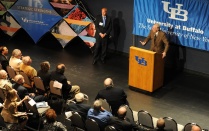Media advisory: UB to hold ribbon cutting and symposium for FOXG1 Research Center
Soo-Kyung and Jae Lee lead the University at Buffalo's FOXG1 Research Center. Photo: Douglas Levere/University at Buffalo
Release Date: September 23, 2024
BUFFALO, N.Y. — On Tuesday, the University at Buffalo will hold a ribbon-cutting ceremony for its new research center dedicated to FOXG1 syndrome, as well as a symposium to share the latest developments in combating the severe neurodevelopmental disorder.
The FOXG1 Research Center (FRC) is led by UB biologists Soo-Kyung and Jae Lee, whose teenage daughter Yuna was born with FOXG1 syndrome and diagnosed at the age of 2.
As leading experts in the field, the Lees’ research has found that the FOXG1 gene and protein remain active in mice after birth, providing hope that some symptoms can be alleviated.
Announced earlier this year, the FRC is supported by the FOXG1 Research Foundation (FRF), as well as UB’s Office of the Vice President for Research and Economic Development.
Where: The Buffalo Room, 10 Capen Hall, on UB’s North Campus.
Schedule for Tuesday, Sept. 24:
9-9:50 a.m. — Opening remarks by officials from UB and FRF, as well as a ribbon-cutting ceremony.
10 a.m.-1 p.m. — A science symposium featuring the Lees and other leading FOXG1 researchers. Topics include a viral gene therapy developed by the Lees that has reversed some brain abnormalities in infant mice with FOXG1 syndrome.
2:30-3:30 p.m. — A tour of the Lee lab, located at 550 Cooke Hall on UB’s North Campus.
Who: Soo-Kyung Lee, Empire Innovation Professor and Om P. Bahl Endowed Professor in the UB Department of Biological Sciences; Jae Lee, a UB professor of biological sciences; Venu Govindaraju, UB vice president for research and economic development; Robin Schulze, dean of the UB College of Arts and Sciences; Nasha Fitter, CEO of the FRF; other leading FOXG1 researchers.
Background: FOXG1 syndrome is characterized by cognitive and physical disabilities, as well as life-threatening seizures. It’s caused by a mutation of the FOXG1 gene, one of the most important genes for early brain development.
There are only about 1,000 known patients diagnosed with FOXG1 syndrome worldwide, but the FOXG1 gene has been linked to autism, Alzheimer’s disease and schizophrenia, suggesting that therapy development may be transferable to more common disorders.
Media Contact Information
Tom Dinki
News Content Manager
Physical sciences, economic development
Tel: 716-645-4584
tfdinki@buffalo.edu

